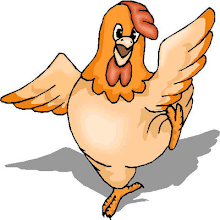Hello fellow chicken lovers. I'm currently playing Call of Duty World at War. It's a very good game but there's unfortunately no chickens in it...
Friday, 9 April 2010
Chicken Guide #2: Yokohama Chicken
 Oh My God the Imperial Army have a new weapon... THE YOKOHAMA CHICKEN.
Oh My God the Imperial Army have a new weapon... THE YOKOHAMA CHICKEN.The Yokohama is a breed of chicken that originated in Germany in the 19th century. It was developed from two different Japanese Cultural Monument breeds, the principle progenitor is the Minohiki or "Saddle Dragger". Some percentage of the ancestral founders were probably another Japanese treasure called the Onagadori, but it is likely that at the time of the founders' introduction to Europe, the lesser known Minohiki was simply not as highly celebrated as the Onagadori. Consequently, many Minohiki were likely confused with Onagadori. Regardless of which of these important breeds were more significant in the development of this unique fowl,the ancestors of today's Yokohama were imported from Yokohama Japan. In appearance, it most closely resembles the Minohiki breed, and to a lesser extent to the European Phoenix Breed, which probably shares many of the same ancestors. The European Phoenix however, has more Onagadori and less Minohiki in its genetic makeup, whilst the opposite is true for the Yokohama Fowl. The Black Sumatran Fowl is a close relative of the Minohiki and Yokohama. The Yokohama is primarily ornamental for many but it is actually an excellent breed for suburban poultry enthusiasts because of its calm demeanor. Better strains of this important breed are also relatively quiet in voice. It lays cream or tinted eggs. If fed a typical lay pellet it will only produce on an average, one egg a week. Fed a higher quality ration with generous proportions of fish and animal protein and fat, it produces an egg a day and all through the winter. The Yokohama is a relatively small breed,only four to five pounds at the very largest. The most distinguished feature of this fowl is its unusual plumage, unique in pattern from all other domestic fowl. It is also celebrated for its long, elegant tail and tail coverts called saddle feathers. It comes both in the bantam and standard sizes. It has yellow skin, and can have either a walnut or a pea comb.
Saturday, 3 April 2010
Chicken Guide #1: Yurlov Crower
 Welcome to my first chicken guide! First up it's the turn of the Yurlov Crower, from Russia. Don't worry, it's not a Spetsnaz.
Welcome to my first chicken guide! First up it's the turn of the Yurlov Crower, from Russia. Don't worry, it's not a Spetsnaz.The Yurlov Crower breed was presumably created in the second half of 19th century by crossing Chinese meat-type breeds, fighting cocks and landraces, but doubtfully with the direct influence of the Malay breed. According to Moiseyeva (1992), the known breed’s plumage color variants are white, silver, scarlet, black with light yellow, or golden, hackle (most of all), and black. The breed was a subject of interest among fancy, commercial and state breeders in Russia and Ukraine for a long time in the 20th century. It has been preserved and studied at few state poultry collection farms since 1970s-1980s. The Geflügel-Börse magazine articles published by two German writers, Rüdiger Wandelt in 1993 and Wolfgang Vits in 1994, introduced the breed to poultry fanciers in Germany. However, the breed was not well known until recent time to a broad community of Western poultry breeders. The continued contacts between German and Russian poultry breeders in 1990s and 2000s led to the import of the Yurlov Crower breed to Western Europe and growth of its popularity first in Germany and then in other European countries. According to the USSR Central Statistic Administration, there were only 200 Yurlov chickens registered in the entire Soviet Union by 1985 (Moiseyeva, 1992). After the USSR disintegration, the breed population in independent Russian Federation, Ukraine and other republics dramatically declined. Based on the data collected in 1993, a Ukrainian strain of Yurlov Crowers (line 92) was included in the second edition of the FAO's World Watch List in 1995 (Scherf, 1995). The breed and line 92 data were also summarized in the third edition of the WWL in 2000 (Scherf, 2000), in which, as of 1993, only 205 Yurlov birds (line 92) kept in Kharkov Region of Ukraine were mentioned and the population status was endangered. The current population of the Yurlov Crower chickens in Russia and Ukraine may be several thousands including both state farms and fanciers. However, bird influenza may represent a serious threat to and decrease numbers of pure chicken breeds (including Yurlovs) in these countries to a large extent. Yeah, deal with it, bitches.
Welcome To All The Different Chickens...
 Hello, I'm Micah, and I like Chickens! This blog I have made will be a guide to all the magical types of Chickens that exist in the strange realm of Earth. I will also be posting about anything I want, so if you are that obssessed with a blog all about chickens, go to the official KFC website and shove it!
Hello, I'm Micah, and I like Chickens! This blog I have made will be a guide to all the magical types of Chickens that exist in the strange realm of Earth. I will also be posting about anything I want, so if you are that obssessed with a blog all about chickens, go to the official KFC website and shove it!Posting will begin from now. Now, let's chicken rave!
Subscribe to:
Comments (Atom)

